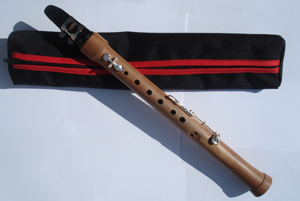Chalumeau facts for kids

The chalumeau ( plural chalumeaux; from Greek: κάλαμος, kalamos, meaning "reed") is a single-reed woodwind instrument of the late baroque and early classical eras. The chalumeau is a folk instrument that is the predecessor to the modern-day clarinet. It has a cylindrical bore with eight tone holes (seven in front and one in back for the thumb) and a broad mouthpiece with a single heteroglot reed
The chalumeau is the oldest form of the clarinet.
It is the first true single reed instrument. The plural for chalumeau is chalumeaux.
Similar instruments
Similar single-reed folk instruments with single, cylindrical tubes are found in many Arabic and European cultures throughout history. See Single-reed instrument, Albogue, Alboka, Diplica, Hornpipe, pibgorn, and Sipsi. Additionally, a similar instrument called the xaphoon (also called "Maui bamboo sax" or "pocket sax") was developed by Hawaiian craftsman Brian Wittman.
The name 'chalumeau' is used by European organ-builders to denote an eight foot short-resonator organ stop used for color effects. This was first encountered in the organ of the Frauenkirche at Dresden and was built by celebrated organ builder Gottfried Silbermann between 1732 and 1736. Silbermann was so pleased with the sound of this new invention that he included it in most of his later organs.
Images for kids
-
Chart of the eight historical chalumeaux that are still in existence today.
The file above's purpose is being discussed and/or is being considered for deletion. See files for discussion to help reach a consensus on what to do.
See also
 In Spanish: Salmoé para niños
In Spanish: Salmoé para niños



